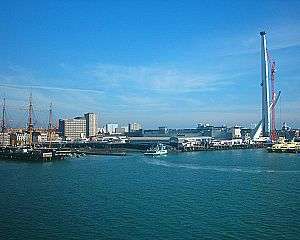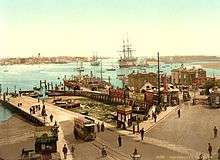Portsmouth Harbour
Coordinates: 50°49′24.60″N 1°7′22.08″W / 50.8235000°N 1.1228000°W


Portsmouth Harbour is a large natural harbour in Hampshire, England. Geographically it is a ria: formerly it was the valley of a stream flowing from Portsdown into the Solent. The city of Portsmouth lies to the east on Portsea Island, and Gosport to the west on the mainland. At its north end is Portchester Castle, of Roman origin and the first fortress built to protect the harbour.

The mouth of the harbour provides access to the Solent. It is best known as the home of the Royal Navy, HMNB Portsmouth. Because of its strategic location on the south coast of England, protected by the natural defence of the Isle of Wight, it has since the Middle Ages been the home to England's (and later Britain's) navy. The narrow entrance, and the forts surrounding it gave it a considerable advantage of being virtually impregnable to attack from the sea. Before the fortifications were built the French burned Portsmouth in 1338.[1] During the civil war parliamentary forces were able to carry out a successful cutting-out expedition within the harbour and capture the six-gunned Henrietta Marie.[2]
In modern times, the harbour has become a major commercial ferry port, with regular services to Le Havre, France, Cherbourg, France, St Malo, France, The Channel Islands and the Isle of Wight. There is a passenger ferry to Gosport. It is also a major area for leisure sailing. In 2006 the Gunwharf Quays development, including the Spinnaker Tower, was opened on the site of HMS Vernon (a former naval shore establishment).
Islands
Portsmouth Harbour contains a number of islands. Whale Island is the home of the HMS Excellent training establishment. Horsea Island is now connected to the mainland due to land reclamation. It is also part of the HMS Excellent establishment. Pewit Island is a small island located in the north western section of Portsmouth Harbour.[3] Closer to the harbour entrance on the Gosport side is Burrow Island, also known as Rat Island.[4]
Camber Dock

50°47′30″N 1°06′24″W / 50.791645°N 1.106565°W
Camber Dock is the oldest developed part of the Portsmouth Harbour complex.[5] Lying within the historic area of Old Portsmouth, it is part of Portsmouth Point that lies outside the original fortified boundaries of Portsmouth. After improvements in the King James's and Landport Gates and the areas military defences,[6] civilian building of dockside storage and ancillary servicing facilities began from 1590.[7] With major ships anchored at Spithead, from the 18th century the surrounding area became noted as a popular but lewd area for visiting sailors.[7]
With advent of bigger steam powered ships, the physical restrictions of Camber Dock meant that it was bypassed for the larger capacity of the newer developed Portsmouth Harbour.[7] Resultantly, Camber Quay became the home of the local fishing fleet, which it still remains today, together with the adjacent dockside development of the commercial fish market. Today it also has a series of visiting berths for non-commercial craft.[5] In 2015, the Land Rover BAR yacht racing headquarters was completed.
Portsmouth ferry port
Launch
Portsmouth investigated three locations for a ferry port at the end of the 1960s and the current location was chosen. The choice was based on cost and the likely benefit of cross-channel ferries. The site was at the end of the newly constructed M275. Originally built with two berths the site opened in 1976 with the Earl William (Sealink) running to the Channel Islands, the Viking Victory (Townsend Thoresen) running to Cherbourg and the Brittany Ferries running to Saint-Malo.
Expansion
All three operators increased their usage of the port during the mid-eighties, which led to expansion. An additional two berths were built, both twin tier. Berth 2 was filled and a new Berth 2 built, which was mainly used by the Earl Granville (Sealink) running to both the Channel Islands and Cherbourg, Berth 1 become more tight to use and the newly roll-on, roll-off Commodore Shipping used it for their Channel Island freight services. Berth 3 was left incomplete while Berth 4 was finished. This was generally considered the Brittany Ferries berth. When Berth 3 was finished Townsend Thoresen moved their passenger operation entirely from Southampton to Portsmouth. Shortly afterwards, Townsend Thoresen bought P&O (Normandy Ferries) and relocated them to Portsmouth. The old Southampton Ferry port was then converted to a marina.
The continued use of Portsmouth saw the creation of Berth 5 and the final stage of development. Portsmouth had seen additional ferry companies Channel Island Ferries, Hoverspeed and Truckline and new routes to Caen, Santander and Bilbao. With the advent of the Channel Tunnel and the abolition of Duty Free most of the companies disappeared. Sealink merged their Channel Island operations with the newly created Channel Island Ferries to create British Channel Island Ferries. They then later relocated operations to Poole before merging into Condor Ferries. Sealink operated to Cherbourg with the Earl Granville for several further years until the Earl Granville violently ran aground off Cherbourg. Hoverspeed ran the HOVERSPEED GB from Portsmouth to Cherbourg intermittently one summer – often the "new ferry of the future" was out of action and the now repaired but ageing Earl Granville would step into the breach – much to passenger annoyance.
Decline
By 2000 Portsmouth only had ferries from Brittany Ferries, Condor and P&O. P&O replaced the ageing Super Vikings with a Ro-pax ship and a Sea-Cat on the Portsmouth-Cherbourg route, but by 2006 P&O had all but closed its operation from Portsmouth but retained the route to Bilbao and Portsmouth became a quiet port again.
After P&O Ferries withdrawal from the Le Havre route in September 2005 a new company stepped in to replace them with LD Lines running one sailing a day to Le Havre with the Norman Spirit.
The Spanish ferry company Acciona tried briefly in 2006 to compete on the northern Spain route to Bilbao using their ferry the Fortuny, but it lasted 3 months before closure.
Today
Today, Brittany Ferries operates a three times daily service to Caen, daily to St Malo, and offers a high-speed seasonal service to Cherbourg, which runs twice daily except on Friday, Saturday & Sunday when it is reduced to daily. An extra morning service to Caen is scheduled. Brittany Ferries also has four sailings a week to Spain with two departures to Bilbao and two to Santander.
LD Lines offers a daily link to Le Havre with additional capacity added by the catamaran Norman Arrow during the high summer months offering one round trip a day.
Condor Ferries have two sailings a day to the Channel Islands with a morning sailing to the Islands with the passenger and freight ferry Commodore Clipper and an evening sailing to the islands with the freight-only ferry Commodore Goodwill.
The sole remaining P&O service to Bilbao ceased in September 2010 but has since been replaced by Brittany Ferries as of April 2011 with two sailings a week using their modern and fast ferry Cap Finistere which can make the trip from Portsmouth to Bilbao in 24 hours with a top cruising speed of 27 knots. On 10 May 2011 the New Terminal building at the newly renamed Portsmouth International Port' was opened by Vince Cable MP. As well as the regular ferry sailings there are 33 small liners booked to berth at the port during 2011
The harbour is going to be dredged to support the arrival of HMS Queen Elizabeth and HMS Prince of Wales, the Navy's first supercarriers.[8]

See also
References
- ↑ Sumption, Jonathan (1999). The Hundred Years War: Trial by Battle. University of Pennsylvania Press. p. 672. ISBN 978-0-8122-1655-4.
- ↑ Webb, John (1977). The Siege of Portsmouth in the Civil War. Portsmouth City Council. p. 14. ISBN 0-901559-33-4.
- ↑ Department of Geography at the University of Portsmouth & The Hampshire and Wight Trust for Maritime Archaeology. "Pewit Island". The Portsmouth Harbour Project. University of Portsmouth, Department of Geography. Retrieved 28 November 2009.
- ↑ Department of Geography at the University of Portsmouth & The Hampshire and Wight Trust for Maritime Archaeology. "Burrow Island". The Portsmouth Harbour Project. University of Portsmouth, Department of Geography. Retrieved 28 November 2009.
- 1 2 "Camber Dock & Quay". Portsmouth International Port. Retrieved 1 July 2014.
- ↑ Patterson, B.H. (1985). A Military Heritage A history of Portsmouth and Portsea Town Fortifications. Fort Cumberland & Portsmouth Militaria Society. pp. 7–15.
- 1 2 3 Webb, J; Quail, S; Haskell, P; Riley, R (1997). The Spirit of Portsmouth: A history. Phillimore & Co. pp. 23–24. ISBN 0-85033-617-1.
- ↑ "Drilling rig starts Portsmouth aircraft carriers work". BBC News. 13 February 2012.
Further reading
- Cowsill, Miles (1995). Ferries of Portsmouth and The Solent. Kilgetty, Pembrokeshire: Ferry Publications. ISBN 1871947286.
External links
| Wikimedia Commons has media related to Portsmouth harbour. |
- Current nautical charts of Portsmouth Harbour and approach channel
- Live streaming web cam overlooking Portsmouth Harbour
